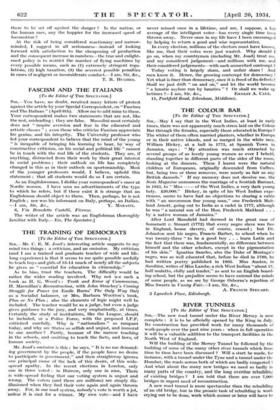THE COLOUR BAR
[To the Editor of THE SPECTATOR.] SIR, May I say that in the West Indies, at least in early times, there was not apparently much stress laid on the Colour Bar through the females, especially those educated in Europe? The whiter of them often married planters, whether in Europe or in their native islands, and so merged in the white race. William Hickey, at a ball in 1775, at Spanish Town in Jamaica, says : " My attention was much attracted by several groups of as lovely young women as ever I beheld, standing together in different parts of the sides of the room, looking at the dancers. These I learnt were the natural children of Europeans, originally descended from Caffres, but, being two or three removes, were nearly as fair as any British damsels." If my memory does not deceive me, the Scots Magazine announces the marriage of a Scottish Baronet, in 1825, to " Miss — of the West Indies, a very dark young lady. 230,000." Hickey, in spite of his West Indian expe- riences, seems to have had no objections to sharing a cabin with " an uncommon fine young man," one Frederick Mait- land Arnott, going out to India as a cadet in 1777, although he was " a natural son of the Hon. Frederick Maitland . . . by a native woman of Jamaica."
After Lord Mansfield had decreed in the great case of Somersett v. Steuart (1772) that every negro slave was free in England, house slavery, of course, ceased ; but Dr. Johnston sent his negro, Francis Barber, to school when he was twenty-three " to be a good boy . . . learn Latin and the fact that there was, fundamentally, no difference between himself and the other scholars, except in the pigmentation of his skin." Ignatius Sancho, also the Duke of Montagu's negro, was so well educated that, before he died in 1780, he had written poetry _published in 1803. Miss Austen, in Sanditon, writes of Miss Lambe, a rich West Indian "about 17, half mulatto, chilly and tender," as sent to an English board- ing school, but the prejudice seems to have entered the minds of some people, as we see_ by George Osborne's rejection of Miss Swartz in Vanity Fair.—I am, Sir, &c., A. FRANCIS STEUART.
2 Lynedoch Place, Edinburgh.












































 Previous page
Previous page